A camping axe is an indispensable tool for any outdoor enthusiast. It serves multiple purposes, from chopping firewood to clearing a path in the wilderness. Its versatility makes it a must-have for any camping trip. The importance of a camping axe cannot be overstated, as it can significantly enhance your outdoor experience.
However, not all camping axes are created equal. The type, size, weight, and material of the axe can greatly affect its performance and suitability for your needs. Therefore, it’s crucial to understand the different aspects of a camping axe to make an informed decision when purchasing one.
This article aims to provide a comprehensive guide on camping axes. It will delve into the various types of camping axes, their uses, key features to look for, and how to maintain them. By the end of this article, you should be well-equipped with the knowledge to choose the right camping axe for your next outdoor adventure.
Our Top Camping Axe Picks
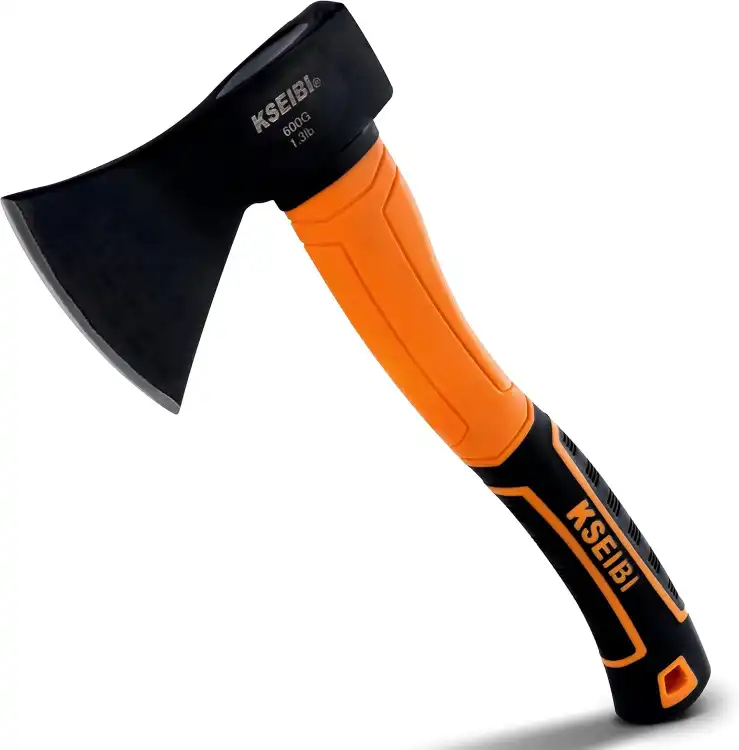
KSEIBI Wood Axe, Small Outdoor Camp Hatchet for Splitting and Kindling Wood
Check on AmazonKey Specs:
- Blade Material: High forged steel, heat-treated
- Handle Length: 14 inches
- Total Length: 15 inches
- Handle Material: Fiberglass
- Weight: Lightweight and ergonomic for easy use
The KSEIBI Wood Axe is an excellent choice for outdoor enthusiasts looking for a versatile and reliable tool. With its high-forged steel blade and heat-treated construction, it ensures durability and maximum efficiency for splitting and chopping wood. The 14-inch fiberglass handle provides a great balance, allowing for increased swing speed and power. Whether you’re camping, hiking, or engaging in outdoor activities, this axe delivers excellent performance. Its ergonomic design and dual functionality make it a must-have for any camping gear collection.
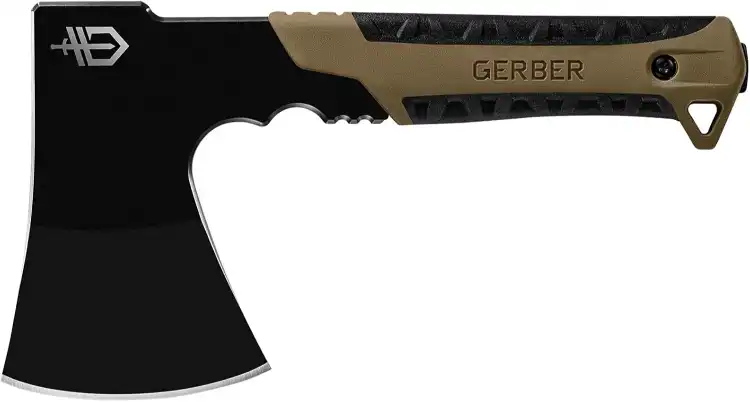
Gerber Gear Pack Hatchet – 3.5″ Steel Blade Axe with Full Tang – Survival
Check on AmazonKey Specs:
- Blade Material: Corrosion-resistant steel with black oxide coating
- Blade Length: 3.5 inches
- Total Length: 9.46 inches
- Handle Material: Rubber with finger grooves
- Weight: 20.8 oz
The Gerber Gear Pack Hatchet is a must-have for anyone who enjoys outdoor activities like camping, hiking, or hunting. The 3.5-inch steel blade, with its corrosion-resistant black oxide coating, ensures durability and sharpness, while the full tang construction provides solid strength. The ergonomic rubber grip handle, with finger grooves, adds extra comfort during use. With its compact design, weighing only 20.8 oz, and the removable nylon sheath for easy carrying, this hatchet is the perfect companion for your adventures.
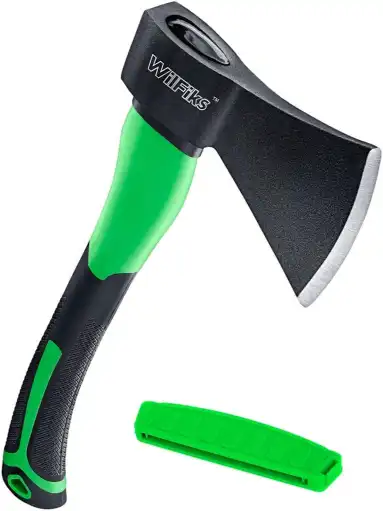
WilFiks Chopping Axe, 15” Camping Outdoor Hatchet for Wood Splitting and Kindling
Check on AmazonKey Specs:
- Blade Material: Forged carbon steel, heat-treated
- Handle Material: Fiberglass with anti-slip grip
- Total Length: 15 inches
- Weight: Lightweight for easy handling
- Storage: Includes protective plastic cover
The WilFiks 15″ Chopping Axe is an excellent choice for campers, hikers, and outdoor enthusiasts. The forged carbon steel heat-treated blade delivers durability and sharpness for efficient chopping. Its ergonomic fiberglass handle with shock absorption and anti-slip grip ensures comfort, reducing hand strain during use. I appreciate the balanced design, which provides smooth, powerful cuts with minimal effort. The blade is easily resharpened, and the included protective cover makes for convenient, safe storage when not in use.
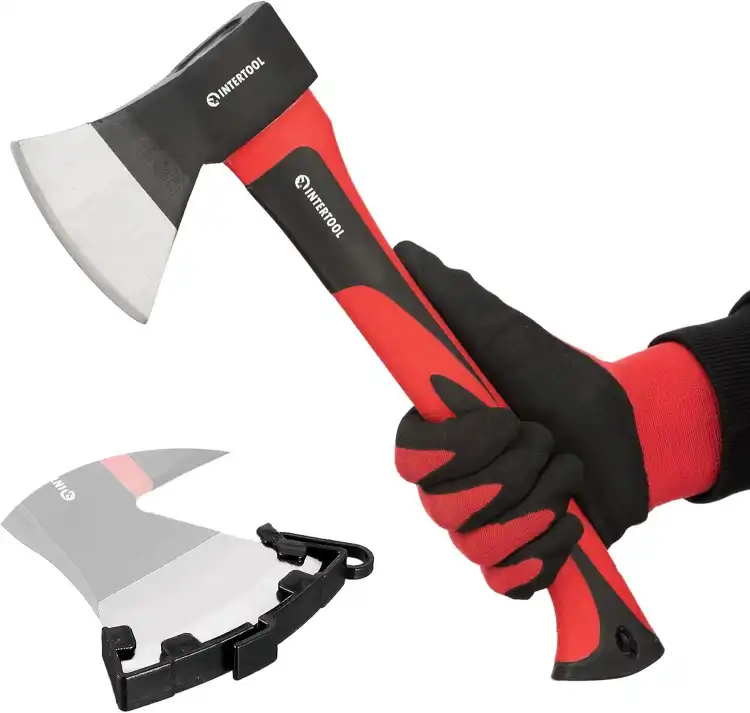
INTERTOOL Camp Hatchet for Firewood Splitting, Chopping, and kindling – Small Wood Axe with Shock-Absorbing Fiberglass Anti-Slip Handle
Check on AmazonKey Specs:
- Blade Material: Sharpened carbon steel with anti-corrosive coating
- Handle Material: Fiberglass and textured rubber for non-slip grip
- Weight: 2 lbs total (head weighs 1.3 lbs)
- Length: 15 inches
- Storage: Hang hole for easy storage and portability
The INTERTOOL Camp Hatchet is a must-have for anyone who enjoys camping, hiking, or working outdoors. The lightweight design at just 1.3 lbs for the head makes it easy to carry while still delivering powerful chopping performance. I love the ergonomic fiberglass handle that absorbs shock, making extended use much more comfortable. The carbon steel blade is sharp right out of the box, with an anti-corrosive coating that ensures durability. Plus, the bright red color makes it easy to spot in any outdoor setting.
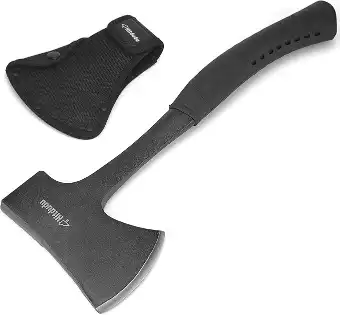
Camping Hatchet, Full Tang Camping Axe Splitting Axe for Wood Splitting and Kindling
Check on AmazonKey Specs:
- Blade Material: Heat-treated carbon steel
- Handle Material: Cold-resistant fiberglass with anti-slip grip
- Weight: 1.98 lbs
- Length: 13.3 inches total, 3.1-inch blade
- Included Accessories: High-quality nylon sheath for safe storage
The Hitdudu Camping Hatchet is an excellent choice for both camping and outdoor adventures. The 13.3-inch full tang design gives it impressive strength, and the heat-treated carbon steel blade ensures sharpness and durability for effortless wood splitting. The ergonomic, shock-absorbing handle reduces hand strain and provides a non-slip grip, making it comfortable for extended use. I particularly appreciate the versatile design that allows for both chopping and throwing. Plus, the nylon sheath ensures safe storage and protection of the blade.
Understanding the Role of a Camping Axe
A camping axe, also known as a hatchet, is primarily used for chopping wood. Whether you need firewood to keep warm or to cook food, a camping axe can make the task much easier and quicker. It can also be used for carving, making kindling, or even as a hammer when needed.
Moreover, a camping axe can be a lifesaver in survival situations. It can be used to build a shelter, hunt for food, or even for self-defense. Therefore, having a reliable camping axe can greatly increase your chances of survival in the wilderness.
However, the effectiveness of a camping axe largely depends on its quality and suitability for the task at hand. A poorly made axe can not only make your tasks more difficult but can also pose a safety risk. Therefore, it’s crucial to choose a camping axe that is durable, reliable, and suitable for your needs.
Types of Camping Axes
There are several types of camping axes, each designed for a specific purpose. Hatchets are the smallest type of camping axe, making them easy to carry and ideal for light tasks such as chopping small logs or branches. They typically have a short handle and a small head, making them easy to use with one hand.
Felling axes, on the other hand, are larger and heavier. They are designed for chopping down trees, hence the name. Their long handles provide more leverage, allowing you to deliver powerful blows. However, their size and weight make them less portable, making them less suitable for backpacking trips.
Splitting axes are designed to split logs along the grain. They have a heavy head with a wide edge, which helps to split the wood more efficiently. Tomahawks, meanwhile, are lightweight and versatile, making them a popular choice for survivalists. They can be used for chopping, slicing, and even throwing.
Factors to Consider When Buying a Camping Axe
When buying a camping axe, the first factor to consider is its purpose. Are you going to use it for chopping firewood, clearing a path, or for survival? The purpose will determine the type of axe you need. For instance, if you need an axe for backpacking trips, a hatchet or a tomahawk would be more suitable due to their lightweight and compact size.
The size and weight of the axe are also important factors to consider. A larger, heavier axe can deliver more powerful blows, but it can also be more difficult to carry and use. Therefore, you need to find a balance between power and portability. The material and construction of the axe are also crucial, as they can affect the durability and performance of the axe.
Lastly, consider the price of the axe. While it’s tempting to go for the cheapest option, remember that you get what you pay for. A cheap axe may not be as durable or effective as a more expensive one. Therefore, it’s worth investing in a high-quality axe that can last for many years.
Understanding Axe Anatomy
An axe consists of two main parts: the head and the handle. The head is the part that does the cutting. It’s usually made of steel and consists of the blade (or bit), the butt (or poll), and the eye (where the handle is fitted). The shape and weight of the head can greatly affect the performance of the axe.
The handle, also known as the haft, is the part that you hold when using the axe. It’s usually made of wood, although some modern axes have handles made of plastic or metal. The length, shape, and material of the handle can affect the balance, grip, and overall usability of the axe.
Understanding the anatomy of an axe is important as it can help you choose the right axe for your needs. For instance, if you need an axe for heavy-duty tasks, you might want to choose one with a heavy head and a long handle. On the other hand, if you need an axe for light tasks, a smaller axe with a lightweight head and a short handle might be more suitable.
Choosing the Right Axe Head
There are several types of axe heads, each designed for a specific purpose. For instance, a splitting axe head has a wedge-shaped design to split wood fibers apart, while a felling axe head has a thinner, sharper design to cut across the grain of the wood. Therefore, the type of axe head you choose should depend on the tasks you plan to use the axe for.
The weight of the axe head is also an important factor to consider. A heavier head can deliver more powerful blows, but it can also make the axe more difficult to swing and control. Therefore, you need to find a balance between power and control. The shape of the axe head can also affect its performance. For instance, a curved blade can cut more deeply into the wood, while a straight blade can provide more control.
The material of the axe head is another crucial factor. Most axe heads are made of steel, but the quality of the steel can vary. High-quality steel is more durable and can hold an edge better, but it’s also more expensive. Therefore, you need to consider your budget and the durability you need when choosing the material of the axe head.
Selecting the Appropriate Axe Handle
The handle of the axe is just as important as the head. It’s the part that you hold when using the axe, so it needs to be comfortable and provide a good grip. There are several types of axe handles, including straight handles, curved handles, and handles with a knob at the end. The type of handle you choose should depend on your personal preference and the tasks you plan to use the axe for.
The length of the handle is also an important factor to consider. A longer handle can provide more leverage, allowing you to deliver more powerful blows. However, it can also make the axe more difficult to control. Therefore, you need to find a balance between power and control. The material of the handle can also affect its durability and comfort. For instance, a wooden handle can provide a comfortable grip and absorb shock well, but it’s also more prone to cracking and breaking.
Lastly, consider the grip of the handle. A good grip can prevent the axe from slipping out of your hand, reducing the risk of accidents. Some axe handles have a rubber or leather grip for added comfort and safety.
Importance of Axe Sharpness
The sharpness of the axe is crucial for its performance. A sharp axe can cut through wood more efficiently, reducing the amount of effort you need to exert. It can also make the task quicker and safer, as a dull axe can bounce off the wood and cause accidents.
However, maintaining the sharpness of the axe requires regular sharpening. This can be done using a sharpening stone or a file. The process involves grinding the edge of the axe until it’s sharp. It’s important to maintain a consistent angle when sharpening the axe to ensure an even edge.
It’s also important to protect the edge of the axe when not in use. This can be done by storing the axe in a sheath or a case. This not only protects the edge, but also prevents accidents.
Safety Features to Look for in a Camping Axe
When choosing a camping axe, safety should be a top priority. One of the key safety features to look for is a sheath for the axe head. This not only protects the edge of the axe, but also prevents accidents. Some sheaths also have a belt loop, allowing you to carry the axe on your belt for easy access.
A non-slip handle is another important safety feature. This can prevent the axe from slipping out of your hand, reducing the risk of accidents. Some axe handles have a rubber or leather grip for added safety and comfort.
Lastly, consider the balance and weight distribution of the axe. A well-balanced axe is easier to control, reducing the risk of accidents. The weight should be evenly distributed between the head and the handle, allowing you to swing the axe with ease.
Top Camping Axe Brands
There are several brands that are known for their high-quality camping axes. Some of the most popular brands include Gransfors Bruks, Hults Bruk, and Fiskars. These brands are known for their durable and reliable axes that are designed for a variety of tasks.
Gransfors Bruks, a Swedish brand, is known for its hand-forged axes that are made using traditional methods. Each axe is signed by the smith who made it, reflecting the brand’s commitment to quality. Hults Bruk, another Swedish brand, is known for its high-quality steel and beautiful designs.
Fiskars, a Finnish brand, is known for its modern designs and innovative features. Their axes are made of high-quality materials and are designed for efficiency and ease of use. They also offer a wide range of axes, from small hatchets to large splitting axes.
Price Range and Where to Buy
The price of a camping axe can vary greatly depending on the brand, type, and quality. A basic camping axe can cost as little as $20, while a high-quality axe from a reputable brand can cost several hundred dollars. Therefore, it’s important to consider your budget and the quality you need when choosing a camping axe.
Camping axes can be purchased from a variety of places, including outdoor equipment stores, hardware stores, and online retailers. When buying a camping axe, it’s important to inspect the axe carefully to ensure its quality. If buying online, make sure to read reviews and check the return policy before making a purchase.
Remember, a good camping axe is an investment. It can last for many years if taken care of properly, so it’s worth spending a bit more for a high-quality axe.
How to Maintain a Camping Axe
Maintaining a camping axe involves regular cleaning, sharpening, and handle care. After each use, clean the axe head with a damp cloth to remove any dirt or sap. Dry the axe thoroughly to prevent rust. If the axe head does get rusty, you can remove the rust using steel wool or sandpaper.
Sharpen the axe regularly to maintain its performance. This can be done using a sharpening stone or a file. Remember to maintain a consistent angle when sharpening the axe to ensure an even edge. After sharpening, apply a thin layer of oil to the axe head to prevent rust.
The handle of the axe also needs regular care. If the handle is made of wood, apply a coat of linseed oil every few months to keep the wood from drying out. If the handle is made of plastic or metal, check it regularly for any cracks or damage.
Common Mistakes to Avoid When Buying a Camping Axe
When buying a camping axe, there are several common mistakes to avoid. One of the most common mistakes is overlooking the importance of weight and balance. A well-balanced axe is easier to control and safer to use. Therefore, it’s important to choose an axe with a weight and balance that you’re comfortable with.
Another common mistake is ignoring the quality of the handle. The handle is the part that you hold when using the axe, so it needs to be comfortable and provide a good grip. A poorly made handle can not only make the axe difficult to use, but can also pose a safety risk.
Lastly, many people make the mistake of not considering the type of camping or outdoor adventure they’ll be undertaking. The type of camping or outdoor adventure will determine the type of axe you need. For instance, if you’re going on a backpacking trip, a lightweight hatchet or tomahawk would be more suitable than a heavy felling axe.
Conclusion
Choosing the right camping axe can greatly enhance your outdoor experience. By understanding the different types of camping axes, their uses, and key features to look for, you can make an informed decision when purchasing a camping axe. Remember, a good camping axe is an investment. With proper care, it can last for many years and serve you well in many outdoor adventures.
Whether you’re a seasoned outdoor enthusiast or a beginner, a camping axe is a must-have tool. It’s versatile, reliable, and can be a lifesaver in survival situations. So, don’t overlook the importance of a camping axe. Choose wisely, take good care of it, and it will serve you well.
Happy camping!
References
For further reading and to gain more knowledge about camping axes, you can refer to the following resources:
- Outdoor Life: Survival Gear – Axes
- Art of Manliness: A Practical Ax Manual
- Popular Mechanics: The 8 Best Axes of 2021
FAQ
What is the best type of camping axe?
The best type of camping axe depends on your needs. If you need an axe for light tasks such as chopping small logs or branches, a hatchet or a tomahawk would be suitable. If you need an axe for heavy-duty tasks such as chopping down trees, a felling axe would be more suitable.
How often should I sharpen my camping axe?
The frequency of sharpening depends on how often you use the axe and the type of tasks you use it for. As a general rule, you should sharpen your axe whenever you notice that it’s not cutting as efficiently as before.
How do I care for a wooden axe handle?
To care for a wooden axe handle, apply a coat of linseed oil every few months to keep the wood from drying out. Also, check the handle regularly for any cracks or damage.
